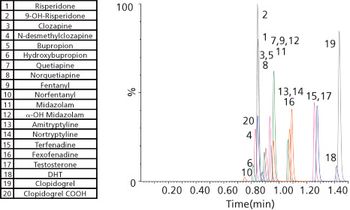
Kenneth J. Fountain
Waters Corporation
Articles by Kenneth J. Fountain


Insulin was the first recombinant pharmaceutical produced. Currently, one of the critical quality control attributes of therapeutic insulin in the US and European Pharmacopoeia (USP and EP) monograph is the level of covalent high molecular weight (HMW) insulin as determined by HPLC size-exclusion chromatography.

The migration to chromatographic methods utilizing smaller particle sizes has been well demonstrated to increase productivity through faster, more efficient separations.

For the analysis of biotherapeutics, size-exclusion and ion-exchange chromatography are typically conducted under native separation conditions, requiring high ionic strength, 100% aqueous eluents.

The growing market for biotherapeutic peptides and the development of quantitative methods for those analytes has brought to light the challenges facing the analysis of this broad range of compounds. Market forces and regulatory requirements are encouraging analytical groups to develop methodologies that are time- and cost-effective, while still producing assays that are sensitive enough to cope with biological matrices.

Although supercritical fluid chromatography (SFC) is not a new technique, preparative SFC is becoming increasingly more popular with advances in instrumentation, software and chemistry.

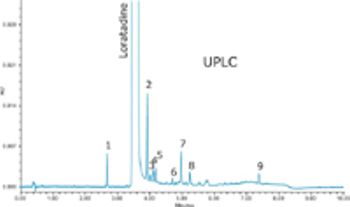
Pharmaceutical research and development (R&D) organizations were early adopters who recognized the many benefits of UltraPerformance LC? (UPLC?) Technology including resolution, sensitivity, throughput, and productivity as compared to HPLC.

Despite recent advances in column technology and stationary phase chemistry, challenges still remain for routine method development and LC/MS applications.
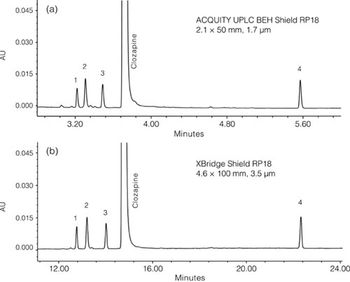
Transferring LC methods between instruments and/or laboratory sites is a common practice that allows analytical scientists to maximize equipment usage.


As UPLC users convert or replace their existing HPLC systems with UPLC systems there is a transition period where a method must be run on both platforms. Thus, having the same particle substrate and bonded phases available in HPLC and UPLC particle sizes can significantly ease the burden of method development and transfer from one platform to another. In addition to the ethylene bridged hybrid (BEH) particle, three new high strength silica (HSS) stationary phases for HPLC applications are introduced. Scalability between both column diameter and particle size is demonstrated on both UPLC and HPLC instrumentation.

Zhe Yin, Kenneth J. Fountain, Erin E. Chambers and Diane M. Diehl, Waters Corporation, Milford, Massachusetts, USA.

Morphine is an effective pain-relieving drug that is primarily metabolized into morphine-3-glucuronide (M3G) and morphine-6-glucuronide (M6G). The highly potent M6G may have adverse effects, such as respiratory depression and renal failure, if accumulated in the body. As morphine abuse continues to affect modern society, an effective method must be established to analyse morphine and its structurally related compounds in biological fluid samples. In this work, a UPLC–MS-MS method was developed to separate six morphine-related compounds on a 2.1 Ã- 100 mm, 1.8 μm ACQUITY UPLC HSS T3 column in a single run using an ACQUITY UPLC system connected to a fast-scanning triple-quadrupole MS detector (TQD). The method achieved adequate retention of these very polar compounds by reversed-phase (RP) chromatography in an 8-min total run time.

Using HILIC with highly efficient ethylene bridged hybrid (BEH) particles results in faster methods that exhibit improved polar retention, higher sensitivity, enhanced chromatographic resolution and significantly improved column lifetime.
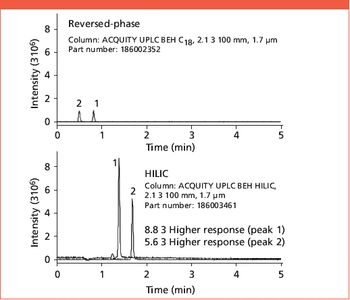
Using HILIC with highly efficient ethylene bridged hybrid (BEH) particles results in faster methods that exhibit improved polar retention, higher sensitivity, enhanced chromatographic resolution, and significantly improved column lifetime.



The effect of switching between high and low pH mobile phases on a single analytical HPLC column was investigated. The ability to rapidly switch between pH extremes on XBridge columns without special washing/re-equilibration steps dramatically reduces the time for separation of pharmaceutical compounds.
Latest Updated Articles
 Rapid, Reliable Metabolite Ratio Evaluation for MIST Assessment in Drug Discovery and Preclinical Studies
Rapid, Reliable Metabolite Ratio Evaluation for MIST Assessment in Drug Discovery and Preclinical StudiesPublished: December 2nd 2012 | Updated:
 Guidelines for Routine Use and Maintenance of Ultra Performance Size Exclusin and Ion Exchange Chromatography Systems
Guidelines for Routine Use and Maintenance of Ultra Performance Size Exclusin and Ion Exchange Chromatography SystemsPublished: February 1st 2012 | Updated:
 Basic Principles for Purification Using Supercritical Fluid Chromatography
Basic Principles for Purification Using Supercritical Fluid ChromatographyPublished: November 1st 2010 | Updated:
 Implementation of Methods Translation between Liquid Chromatography Instrumentation
Implementation of Methods Translation between Liquid Chromatography InstrumentationPublished: October 1st 2010 | Updated:
 Practical Applications of Charged Surface Hybrid (CSH) Technology
Practical Applications of Charged Surface Hybrid (CSH) TechnologyPublished: October 1st 2010 | Updated:
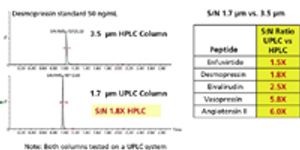 A Strategic Approach to the Quantification of Therapeutic Peptides in Biological Fluids
A Strategic Approach to the Quantification of Therapeutic Peptides in Biological FluidsPublished: April 1st 2011 | Updated: